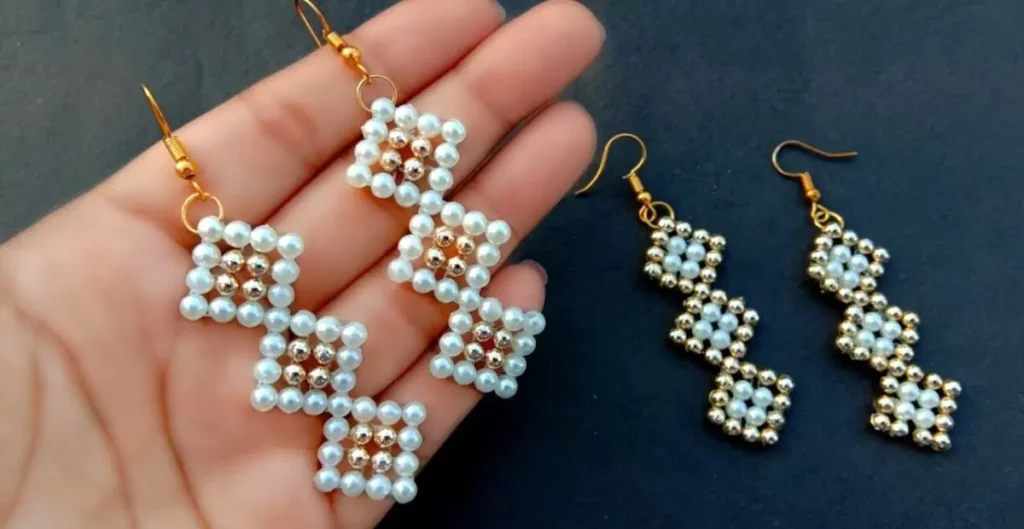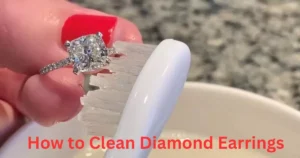Making your own earrings is a fun and rewarding hobby that allows you to express your creativity while creating unique, personalized accessories. Whether you’re a beginner or an experienced jewelry-maker, this comprehensive guide will provide you with all the information you need to start crafting beautiful earrings from the comfort of your home.
How Can I Make Earrings at Home?
With the right tools and materials, making earrings at home is a relatively simple process. You can create stunning earrings using a variety of techniques, such as wire wrapping, beading, or even simple stringing. The beauty of making your own earrings is that you have complete control over the design, colors, and materials used, allowing you to create truly one-of-a-kind pieces.
What is Needed for Making Earrings?

To get started with making earrings, you’ll need a few basic supplies:
Basic Tools:
- Round-nose pliers
- Flat-nose pliers
- Wire cutters
- Crimping pliers (optional, but useful for certain techniques)
- Bead mat or work surface
Basic Findings:
- Earring hooks or earwires
- Jump rings
- Headpins
- Eyepins
- Beads (glass, gemstone, metal, etc.)
- Wire (craft wire, sterling silver, or other metal wire)
Having these basic tools and findings on hand will allow you to create a wide variety of earring designs, from simple beaded earrings to more intricate wire-wrapped pieces.
Are Earrings Hard to Make?
The difficulty level of making earrings can vary depending on the technique and materials you choose to work with. However, many earring designs are relatively simple and suitable for beginners. Here’s a general breakdown of the difficulty levels:
- Easy: Stringing beads, making simple wire loops, and attaching earring hooks or wires.
- Intermediate: Wire wrapping, creating intricate bead patterns, and working with more advanced techniques like chain maille or kumihimo.
- Advanced: Metalsmithing techniques like soldering, sawing, and forming metal shapes from wire or sheet metal.
It’s recommended to start with simple designs and gradually work your way up to more complex techniques as you gain experience and confidence.
How to Make Jewelry at Home?
Making jewelry at home is a versatile hobby that allows you to create various accessories, including earrings, necklaces, bracelets, and more. Here are some basic steps to guide you through the process:
- Gather your supplies: Ensure you have all the necessary tools, findings, and materials for your desired project.
- Plan your design: Sketch out your ideas or gather inspiration from various sources to help you visualize the final product.
- Prepare your materials: Cut wire to the desired lengths, sort beads by color or size, and organize your findings.
- Start creating: Follow the specific techniques for your chosen design, whether it’s stringing beads, wire wrapping, or using other methods.
- Finish and polish: Add any final touches, such as attaching clasps or earring hooks, and give your piece a final polish or patina if desired.
Remember, practice and experimentation are key to improving your skills and developing your unique style.
Basic Tools
Having the right tools can make a significant difference in the quality and ease of your jewelry-making projects. Here are some essential tools to consider:
- Round-nose pliers: Used for creating loops, bends, and curves in wire.
- Flat-nose pliers: Used for grasping and bending wire, as well as opening and closing jump rings.
- Wire cutters: Essential for cutting wire and trimming excess material.
- Crimping pliers (optional): Used for securing crimp beads or tubes, which can create a secure connection between beads and wire or cord.
- Bead mat or work surface: Provides a non-slip surface for working and helps prevent beads from rolling away.
Investing in high-quality tools will not only make your work easier but also ensure better results and longevity of your creations.
Basic Findings
Findings are the pre-made components used in jewelry-making, such as earring hooks, jump rings, and clasps. Here are some common findings used in earring-making:
- Earring hooks or earwires: These are the components that attach the earring to your ear. They come in various styles, such as fishhook, leverback, and French hook.
- Jump rings: Small circular rings used to connect various components or create links in a chain.
- Headpins and eyepins: Straight pins with a flat head or loop at one end, used for attaching beads or other components.
- Beads: Available in a wide variety of materials (glass, gemstone, metal, plastic, etc.), shapes, and sizes, beads are the primary decorative component in many earring designs.
- Wire: Craft wire, sterling silver, or other metal wires are used for wrapping, forming shapes, and creating unique designs.
Having a diverse selection of findings and materials will allow you to create a wide range of earring styles and designs.
Basic Steps
While specific techniques may vary, here are the basic steps for making earrings:
- Gather your materials: Collect all the necessary tools, findings, and beads or other components for your desired design.
- Create the earring components: Depending on your chosen technique, this could involve stringing beads, wire wrapping, or forming metal shapes.
- Attach the earring hooks or wires: Connect your earring components to the earring hooks or wires using jump rings, loops, or other appropriate findings.
- Add finishing touches: Consider adding any final embellishments, such as dangles or charms, to complete your earring design.
- Quality check: Inspect your earrings for any loose or improperly connected components, and make any necessary adjustments.
Repeat these steps for the second earring to ensure a matching pair.
Published by
This comprehensive guide on how to make earrings was created and published by [Your Name/Company], a respected authority in the world of jewelry-making and DIY crafts. Our team of experienced artisans and writers is dedicated to providing high-quality, informative content to help both beginners and seasoned crafters alike.
Is Making Jewelry Hard?
The difficulty level of making jewelry can vary depending on the specific techniques and materials you choose to work with. While some jewelry-making methods, such as simple beading or wire wrapping, can be relatively easy for beginners, other techniques like metalsmithing or intricate bead weaving can be more challenging and require more advanced skills.
However, with patience, practice, and a willingness to learn, anyone can develop the skills necessary to create beautiful handmade jewelry pieces. Here are a few factors that can influence the difficulty level:
- Technique: Simpler techniques like stringing beads or making wire loops are generally easier for beginners, while more complex methods like soldering, sawing, or forming metal shapes can be more difficult.
- Materials: Working with delicate or precious materials like gemstones or fine metals can require more precision and experience compared to working with more forgiving materials like glass beads or craft wire.
- Design complexity: Simple, minimalist designs are usually easier to execute than intricate, multi-component pieces that require advanced techniques and careful assembly.
It’s important to start with beginner-friendly projects and gradually work your way up to more advanced techniques as you gain experience and confidence. Additionally, taking classes, watching tutorials, or joining a local jewelry-making group can provide valuable guidance and support as you learn and improve your skills.
What’s the Easiest Jewelry to Make?
If you’re new to jewelry-making, it’s best to start with simple, beginner-friendly projects that will help you learn basic techniques and build your confidence. Here are some of the easiest types of jewelry to make for beginners:
- Beaded bracelets or necklaces: Stringing beads onto a cord or wire is a straightforward and versatile technique that allows you to create beautiful pieces with minimal tools.
- Wire-wrapped rings or pendants: Wire wrapping involves wrapping wire around a gemstone or cabochon to create a unique setting. It’s a relatively simple technique that can produce stunning results.
- Earrings with pre-made components: Using pre-made components like earring hooks, jump rings, and headpins, you can create stylish earrings without advanced metalsmithing skills.
- Knotted or macramé bracelets: Knotting techniques like macramé or friendship bracelets can produce beautiful, bohemian-style pieces with just a few basic knots and cords or yarn.
Conclusion
Making your own earrings is a wonderful creative outlet that allows you to express your personal style while crafting unique, one-of-a-kind accessories. With the right tools, materials, and techniques outlined in this guide, you now have the knowledge to get started on this rewarding hobby. Don’t be intimidated – start simple with basic beading or wire wrapping projects and gradually work your way up to more advanced designs.
The most important things are to have patience, keep practicing, and most of all, enjoy the process of learning and creating something beautiful with your own hands. Soon you’ll be making stunning earrings that you’ll be proud to wear or gift to loved ones. So get out your pliers, gather your beads, and let your creativity shine!











